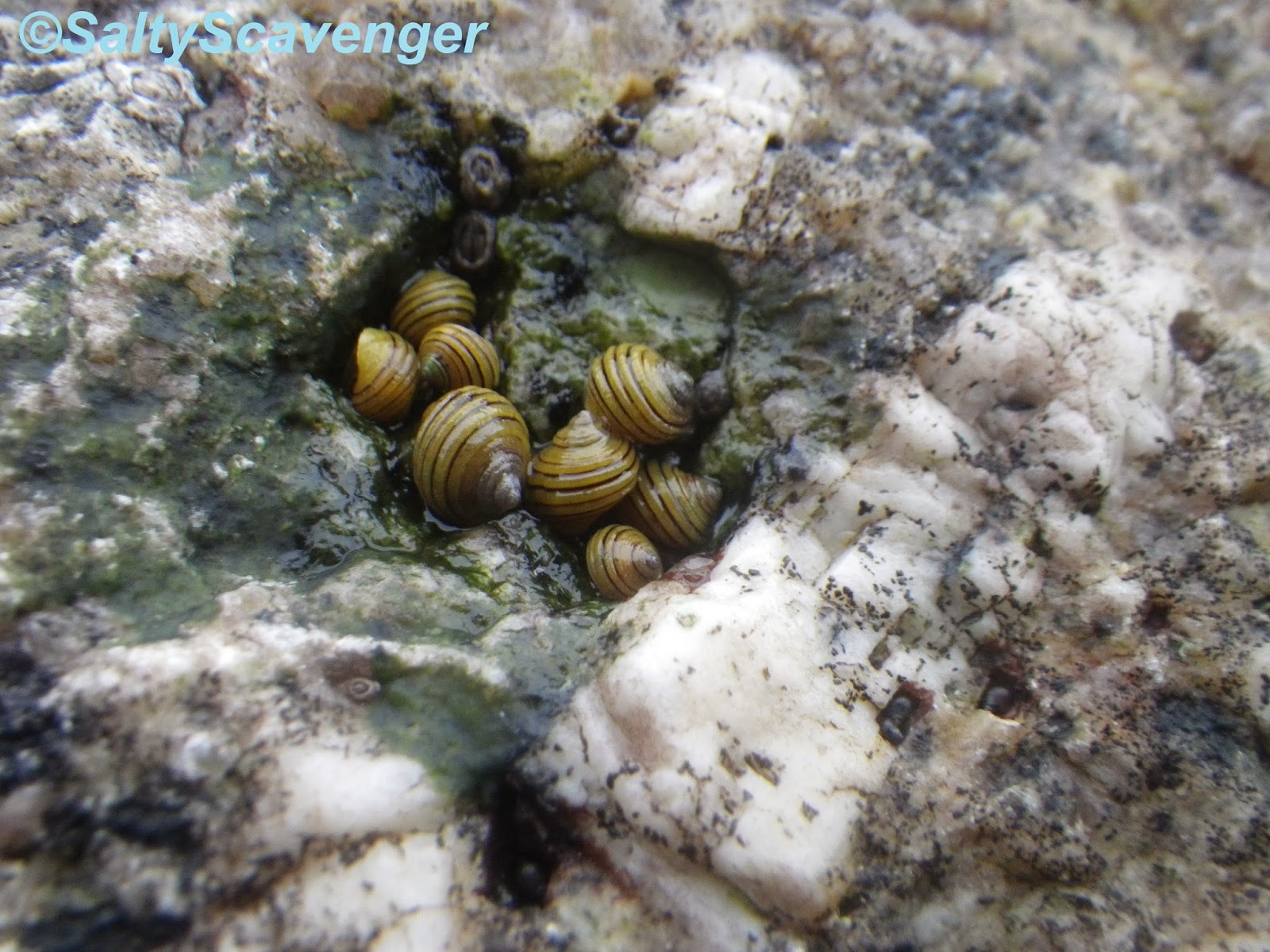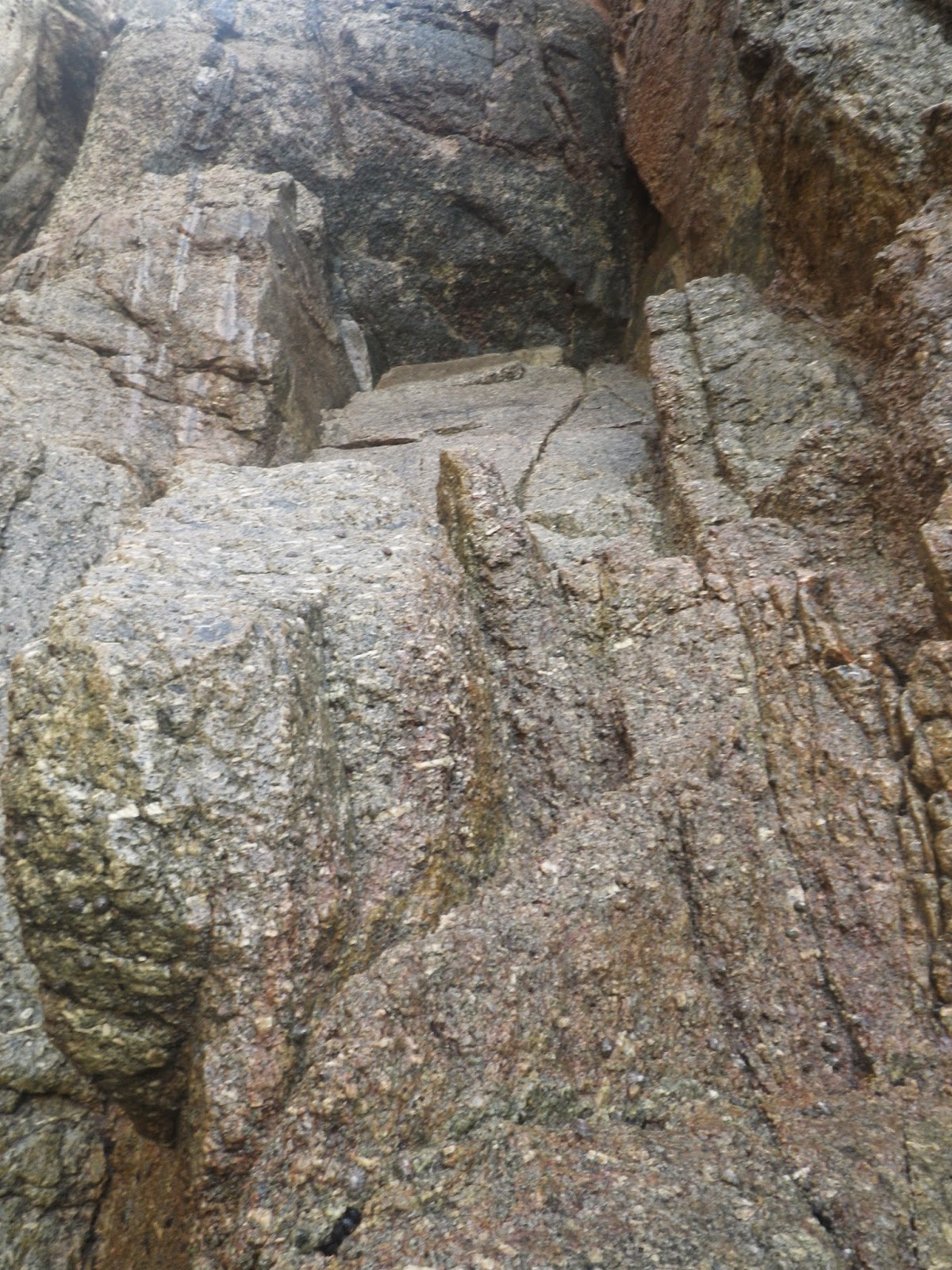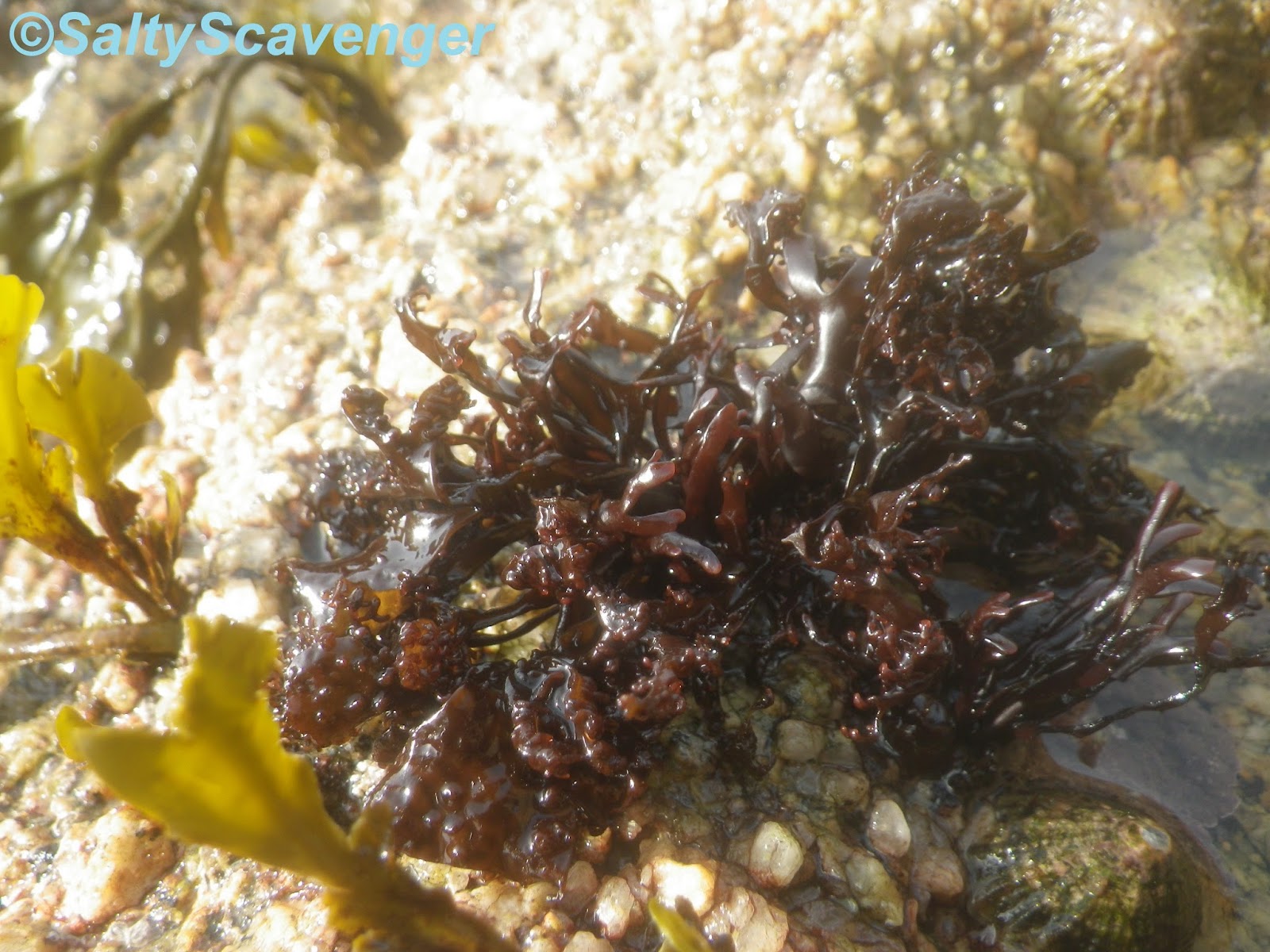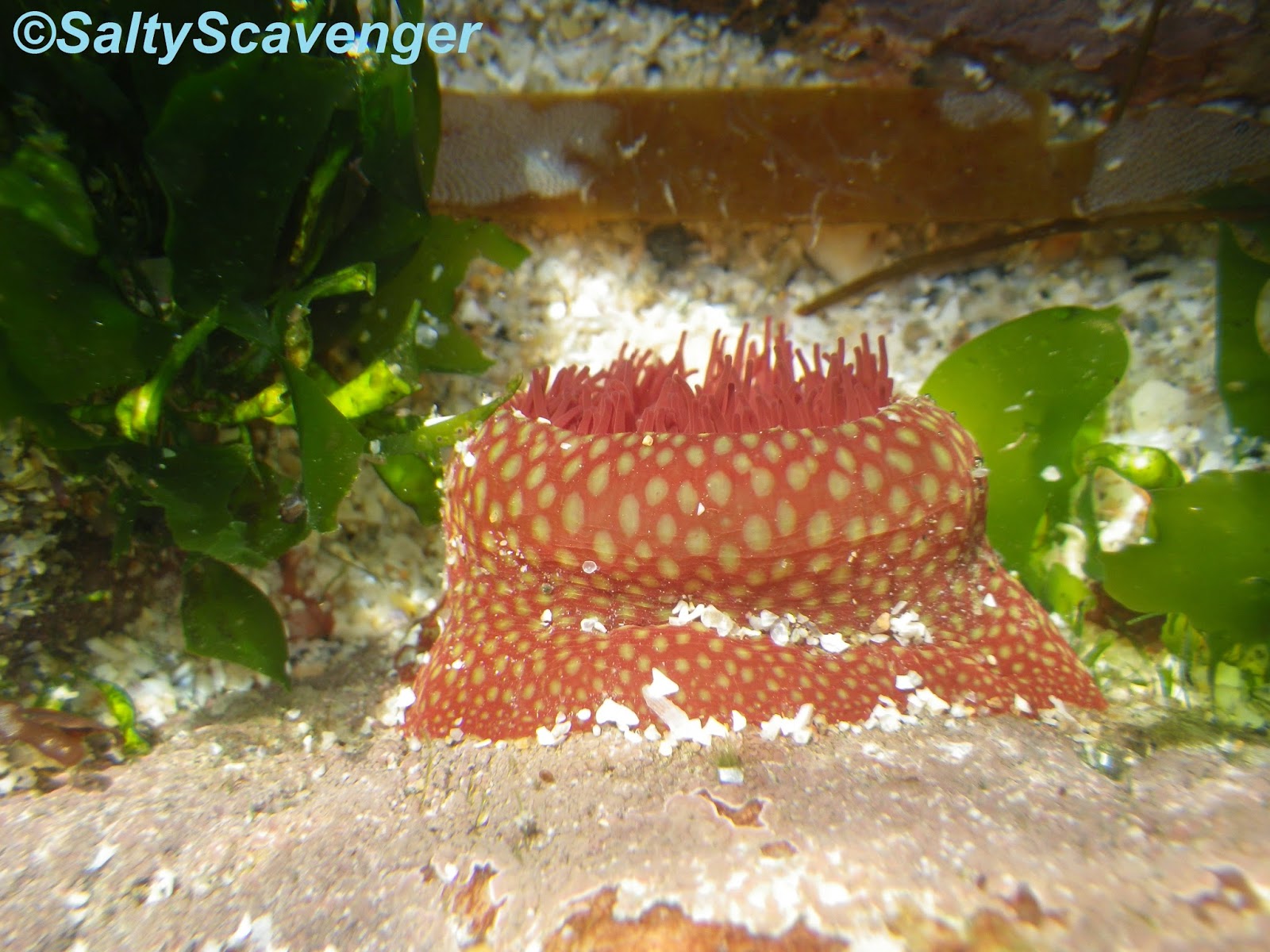The bay experiences a dynamic regime, alternating between periods of erosion and deposition. The underlying substrate is boulders and bedrock, however, variable amounts of sand may be deposited on top, sourced from the sand bar situated offshore. The communities encountered reflect the alternation between these regimes.
 |
| September, 2013 |
The shore alternates between periods of deposition, sandy and erosion, stony.
 |
October, 2014
|
At the time of visitation the cove was comprised of boulders and bedrock with an occasional thin veneer of sand.
Steep cliffs surround the bay, the lower craggy edges covered in lichens. The cliff bases and steeper bedrock transition between the lichen and barnacle communities with limpets, periwinkles and whelks. Boulders and bedrock of the mid and lower shore host a similar barnacle community plus a variety of seaweeds, including where sand scour is event, ephemeral seaweeds. Rockpools occur throughout the shore, and a river flows downs from the cliffs.
Habitat classification:
Substrate
|
LR (Littoral rock)
|
Habitat
|
LR.HLR (High energy littoral rock)
|
LR.MLR (Moderate energy littoral
rock)
|
LR.FLR (Features of ilttoral rock)
|
Biotope complex
|
LR.
HLR.MusB (Mussels and/or
barnacles on high energy littoral rock)
|
LR.MLR.BF (Barnacles and fucoids on
moderately exposed shores)
|
LR.FLR.Lic.(Lichens on supralittoral
and littoral fringe rock).
|
LR.FLR.Rkp (Rockpools)
|
LR.FLR.Eph (Ephemeral green or red seaweed
communities
|
LR.FLR.CvoV (Littoral caves and
overhangs).
|
Biotope
|
|
LR.MLR.BF.Fser (Fucus serratus on
moderately exposed eulittoral rock)
|
LR.MLR.BF.Rho (Rhodothamniella
floridula on sand scoured lower eulittoral rock)
|
LR.FLR.Lic.Ver (Verrucaria Maura on
littoral fringe rock)
|
LR.FLR.Rkp.Cor (Coralline
crust-dominated shallow eulittoral rockpools)
|
LR.FLR.Rckp.SwSed (Seaweeds in sediment-
floored eulittoral rockpools).
|
LR.FLR.Eph (Ephermeral green or red
seaweeds (Fresh water or sand influenced)
|
LR.FLR.Eph.EntPor (Porphyra purpurea
and Entomorpha spp. on sand scoured mid to
lower eulittoral rock)
|
|
Sub Biotope
|
|
LR.MLR.BF.Fser.R (Fucus serratus and
red seaweeds on moderately exposed lower eulittoral rock)
|
|
|
LR.FLR.Rkp.Cor.Cor (Corallina
officinalis and coralline crusts in shallow eulittoral rockpools)
|
|
|
|
|
Below are images of organisms you may encounter whilst rockpooling within these habitats:
 |
Since April, 2014 the cove has comprised bedrock, boulders and cobbles.
|
The littoral fringe bedrock supports a community of tar lichen (Verrucaria maura), periwinkles and occasional limpets and barnacles. Habitat classification: LR.FLR.Lic.Ver (Verrucaria maura on littoral fringe rock) EUNIS: B3.113.
 |
| Bedrock and boulders that a year ago were covered by sand are now slowly being colonized by fauna, many of whom appear to have moved down the rock from the Verrucaria maura and ephemeral green seaweed communities. Small periwinkles (Melarhaphe neritoides), Rough periwinkles (Littorina sp) and limpets occur on the gully sides, whilst rockpools and boulders are becoming colonised by ephemeral greens. |
Periwinkles occur on the shore and are one of the most prominent mobile fauna of the littoral fringe and upper shore.
 |
| Small periwinkles (Melarhaphe neritoides). |
 |
| Rough periwinkles (Littorina sp). |
 |
| Rough periwinkle (Littorina compressa). |
 |
| Rough periwinkle (Littorina sp). |
 |
| Rough periwinkle (Littorina compressa nigrolineata). |

Rough periwinkles (Littorina saxatilis agg and Littorina compressa nigrolineata).

Rough periwinkles (Littorina saxatilis agg and Littorina compressa nigrolineata). |
 |
| Previously high levels of sand scour have limited species colonisation of the bedrock. Barnacles are scarce and organisms such as limpets (Patella valgata) and periwinkles are confined to crevices and leeward enclaves that offer protection from the waves and sand scour. Fucoids grow in occasional clumps, which are currently exhibiting seasonal die back. |
 |
| The cliff bases hold a number of small coralline rockpools that support corallinaceae crusts, limpets and red seaweeds. Habitat classification: LR.FLR.Rkp.Cor (Coralline crust-dominated shallow eulittoral rockpools) EUNIS: A1.411 |
 |
| A coralline rockpool with limpets, corallinaceae crusts and ephemeral green seaweeds. |
 |
| A deeper coralline rockpool further down the shore, with red seaweeds, including Corallinaceae crusts, Corallina officinalis and bootlace weed (Himanthalia elongata). |
 |
| C. officinalis within a coralline rockpool. |
 |
| A china limpet (Patella ulyssiponensis) which favours coralline rockpools. |
 |
| Rhodophyta within a coralline rockpool. |
 |
| Corallinaceae crusts are beginning to grow within the newly available rockpools. |
 |
| A blenny (Lipophrys pholis) within a rockpool. Habitat classification: LR.FLR.Rkp (Rockpools) EUNIS: A1.41. |
 |
| The distribution of fauna in the mid and lower shore is influenced by wave exposure, subtidal sand scour, fresh water runoff and desiccation. The result is a patchwork of biotopes that are not distributed evenly down the shore. Here the mid shore boulders are covered in ephemeral greens and the lower shore boulders are colonised by a patchwork of barnacles and fucoids. Habitat classification: LR.MLR. BF (Barnacles and fucoids on moderately exposed shores) and LR.FLR.Eph (Ephermeral green or red seaweeds (Fresh water or sand influenced). |
 |
This image of the shore taken in September, 2013 shows that there has since been extensive sand erosion, increasing the available hard substrate and abundance of ephemeral greens. http://thesaltyscavenger.blogspot.co.uk/2014/02/rockpooling-destination-lands-end.html
|
 |
By October, many of the perennial seaweeds are exhibiting seasonal dieback.
The longer lived seaweeds of this shore have to endure periodic sand cover and scour.
 The same general area in September, 2013 shows the seaweed covered by sand.
Blog post http://www.thesaltyscavenger.blogspot.co.uk/2014/02/rockpooling-destination-lands-end.html.
The same general area in September, 2013 shows the seaweed covered by sand.
Blog post http://www.thesaltyscavenger.blogspot.co.uk/2014/02/rockpooling-destination-lands-end.html.
|
 |
| Thick topshell (Osilinus lineatus) |
 |
| O. lineatus. |
 |
Ephemeral green algae (Entomorpha/Ulva sp) cover the relatively newly available boulders.Habitat classification: LR.FLR.Eph (Ephemeral green or red seaweed communities) EUNIS: A1.45.
|
 |
| The cliff bases and boulders of the mid and lower shore that experience sand scour are also covered in Ephemeral green algae. Habitat classification: LR.FLR.Eph.EntPor (Porphyra urpurea or Entomorpha spp. on sand scoured mid to lower eulittoral rock). EUNIS A1.452 |
 |
| Ephemeral green algae and Porphyra sp cover mid and lower shore sand scoured boulders. |
 |
| In areas of the lower shore that experience sand scour the scour tolerant, sand binder (Rhodothamniella floridula) occurs. Habitat classification: LR.MLR.BF.Rho (Rhodothamniella floridula on sand scoured lower eulittoral rock) |
 |
The scour tolerant, R. floridula and ephemeral green algae (Entomorpha sp).
 |
Mastocarpus stellatus, F. serratus, R. floridula and the ephemeral green seaweed, Cladophora rupestris.
|
|
Where sand scour is reduced, barnacles, dog whelks (N. lapillus) and limpets cover the larger, more exposed boulders, whilst fucoid and red seaweeds colonise rock and boulders below. Habitat classification: LR.MLR.BF.Fser.R (Fucus serratus and red seaweeds on moderately exposed lower eulittoral rock).
M. stellatus forms a mosaic distribution with F. serratus. which is characteristic of the biotope LR.MLR.BF.Fser.R (Fucus serratus and red seaweeds on moderately exposed lower eulittoral rock).
 |
| F. serratus, M. stellatus and C. rupestris with F. serratus showing seasonal die back. |
The ephemeral green seaweed, Cladophora rupestris.
 |
| Mastocarpus stellatus |
 |
A polychaete on the lower shore.
|
Between the boulders of the lower shore are sediment filled rockpools which support a variety of seaweeds species including, F. serratus and red seaweeds including, C. officinalis, R. floridula and ephemeral greens. LR.FLR.Rkp.SwSed (Seaweeds in sediment-floored eulittoral rockpools) EUNIS:A1.413.
 |
| Sand binder (Rhodothamniella floridula) |
 |
| Rhodophtya |
 |
| Possible black scour weed (Ahnfeltia plicata). |
 |
| Rhodophyta |
 |
| Coral weed (Corallina sp) |
 |
| Combweed (Plocamium cartilagineum) |
 |
| Lomentaria articulata |
 |
| A hydrozoa |
 |
| Gibbula umbilicus |
 |
| A chiton |
A strawberry anemone (Actina fragacea).
 |
| A. fragacea |
 |
| Sea caves on the shore provide shade allowing species who are more sensitive to sunlight to extend their occurrence beyond that of the rockpools. Habitat classification: LR.FLR.CvoV (Littoral caves and overhangs) EUNIS: A1.44. |
 |
M. stellatus, A.equina and coralinaceae crusts live in the shaded entrance of the sea cave.
|
 |
| Corallinaceae crusts occur within and extend beyond the rockpools of the cave entrance due to the shade provided by the overhanging cliff. |
A raven looks among the shore......


















































































